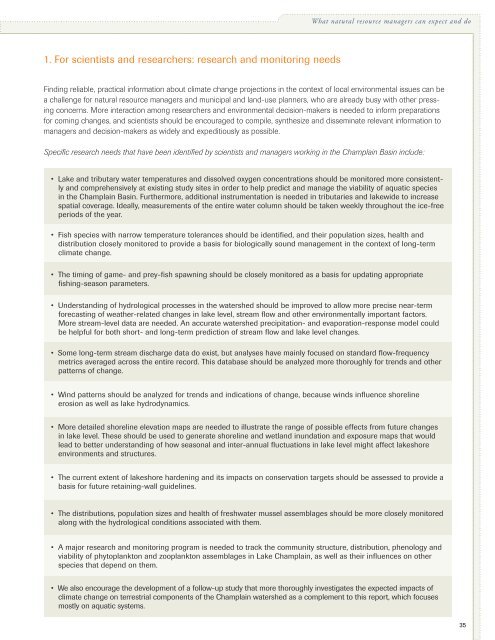Climate Change in the Champlain Basin - The Nature Conservancy
Climate Change in the Champlain Basin - The Nature Conservancy
Climate Change in the Champlain Basin - The Nature Conservancy
Create successful ePaper yourself
Turn your PDF publications into a flip-book with our unique Google optimized e-Paper software.
What natural resource managers can expect and do1. For scientists and researchers: research and monitor<strong>in</strong>g needsF<strong>in</strong>d<strong>in</strong>g reliable, practical <strong>in</strong>formation about climate change projections <strong>in</strong> <strong>the</strong> context of local environmental issues can bea challenge for natural resource managers and municipal and land-use planners, who are already busy with o<strong>the</strong>r press<strong>in</strong>gconcerns. More <strong>in</strong>teraction among researchers and environmental decision-makers is needed to <strong>in</strong>form preparationsfor com<strong>in</strong>g changes, and scientists should be encouraged to compile, syn<strong>the</strong>size and dissem<strong>in</strong>ate relevant <strong>in</strong>formation tomanagers and decision-makers as widely and expeditiously as possible.Specific research needs that have been identified by scientists and managers work<strong>in</strong>g <strong>in</strong> <strong>the</strong> Champla<strong>in</strong> Bas<strong>in</strong> <strong>in</strong>clude:• Lake and tributary water temperatures and dissolved oxygen concentrations should be monitored more consistentlyand comprehensively at exist<strong>in</strong>g study sites <strong>in</strong> order to help predict and manage <strong>the</strong> viability of aquatic species<strong>in</strong> <strong>the</strong> Champla<strong>in</strong> Bas<strong>in</strong>. Fur<strong>the</strong>rmore, additional <strong>in</strong>strumentation is needed <strong>in</strong> tributaries and lakewide to <strong>in</strong>creasespatial coverage. Ideally, measurements of <strong>the</strong> entire water column should be taken weekly throughout <strong>the</strong> ice-freeperiods of <strong>the</strong> year.• Fish species with narrow temperature tolerances should be identified, and <strong>the</strong>ir population sizes, health anddistribution closely monitored to provide a basis for biologically sound management <strong>in</strong> <strong>the</strong> context of long-termclimate change.• <strong>The</strong> tim<strong>in</strong>g of game- and prey-fish spawn<strong>in</strong>g should be closely monitored as a basis for updat<strong>in</strong>g appropriatefish<strong>in</strong>g-season parameters.• Understand<strong>in</strong>g of hydrological processes <strong>in</strong> <strong>the</strong> watershed should be improved to allow more precise near-termforecast<strong>in</strong>g of wea<strong>the</strong>r-related changes <strong>in</strong> lake level, stream flow and o<strong>the</strong>r environmentally important factors.More stream-level data are needed. An accurate watershed precipitation- and evaporation-response model couldbe helpful for both short- and long-term prediction of stream flow and lake level changes.• Some long-term stream discharge data do exist, but analyses have ma<strong>in</strong>ly focused on standard flow-frequencymetrics averaged across <strong>the</strong> entire record. This database should be analyzed more thoroughly for trends and o<strong>the</strong>rpatterns of change.• W<strong>in</strong>d patterns should be analyzed for trends and <strong>in</strong>dications of change, because w<strong>in</strong>ds <strong>in</strong>fluence shorel<strong>in</strong>eerosion as well as lake hydrodynamics.• More detailed shorel<strong>in</strong>e elevation maps are needed to illustrate <strong>the</strong> range of possible effects from future changes<strong>in</strong> lake level. <strong>The</strong>se should be used to generate shorel<strong>in</strong>e and wetland <strong>in</strong>undation and exposure maps that wouldlead to better understand<strong>in</strong>g of how seasonal and <strong>in</strong>ter-annual fluctuations <strong>in</strong> lake level might affect lakeshoreenvironments and structures.• <strong>The</strong> current extent of lakeshore harden<strong>in</strong>g and its impacts on conservation targets should be assessed to provide abasis for future reta<strong>in</strong><strong>in</strong>g-wall guidel<strong>in</strong>es.• <strong>The</strong> distributions, population sizes and health of freshwater mussel assemblages should be more closely monitoredalong with <strong>the</strong> hydrological conditions associated with <strong>the</strong>m.• A major research and monitor<strong>in</strong>g program is needed to track <strong>the</strong> community structure, distribution, phenology andviability of phytoplankton and zooplankton assemblages <strong>in</strong> Lake Champla<strong>in</strong>, as well as <strong>the</strong>ir <strong>in</strong>fluences on o<strong>the</strong>rspecies that depend on <strong>the</strong>m.• We also encourage <strong>the</strong> development of a follow-up study that more thoroughly <strong>in</strong>vestigates <strong>the</strong> expected impacts ofclimate change on terrestrial components of <strong>the</strong> Champla<strong>in</strong> watershed as a complement to this report, which focusesmostly on aquatic systems.35
















